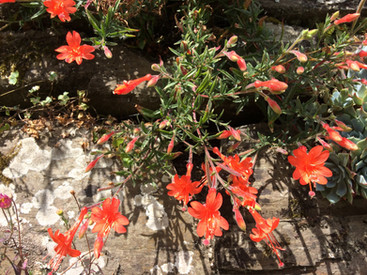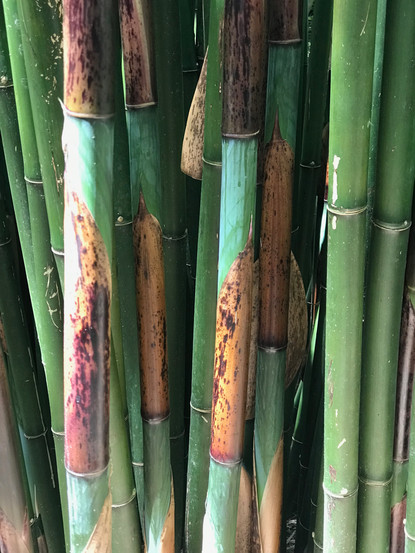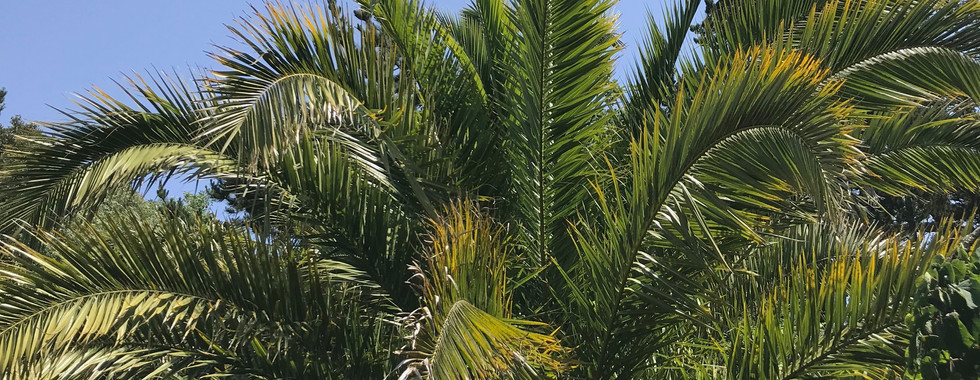TREBAH GARDENS , FALL IN LOVE!
- Admin

- Aug 13, 2020
- 5 min read
As we all slowly come out of Covid lockdown, we all need a spiritual lift. My number one recommendation to elevate the soul is a visit to one of our nations incredible historic gardens and for me, there is one place my mind’s eye takes me to. When thinking of this happy place, my ‘Jack Sparrow’ compass points south to Cornwall and a hidden valley near Falmouth…. TREBAH… even sounds like a pirate cry.
Trebah gardens are simply fantastic, historic, magical, inspirational and filled with botanical delights. Having visited Trebah for over 20 years, I felt it was about time I gave back some of the good Kama with this Trebah gardens guide.

Arrive, park and then check in at the visitors centre. Turn right and walk through a narrow pathway surrounded by Camellia and a large Butia palm to a huge open lawn to the South and a raised bed to the North. The Valley view is spectacular , with views all the way to the sea. The raised beds feature a couple of massive Agave (Agave gentryi) and a stunning example of the spiral aloe (Aloe polyphylla). Cascading over the raised succulent bed is the dainty Zauschneria californica, with it’s charming red fuchsia like flowers . To the south of the high formal path are giant tree ferns. Legend has it that these massive Dicksonia antarctica arrived at Trebah as ballast in returning trading ships from Tasmania in the 1860’s , if true, this makes many of the biggest examples well over 200 years old.

Mixed with the huge tree fens is a sprawling hedge formed by the strange Acacia pravissima or ‘Oven’s Wattle’, another Australian import and possible here as a result of seeds travelling on the tree fern trunks. The strange triangular leaves of the ‘Ovens Wattle’ are arranged in spirals around the stems and branches of this ancient looking shrub, adding to the jurassic feel of the planting.
Now the pathway starts to meander down into the valley.

There are a couple of routes to choose from, both equally enchanting. Here you pass Hedchium gingers and Canna which flourish next to the tumbling stream. The Stream flattens out briefly to create a boggy area populated by stunning candelabra species of primula. The stream continues down the valley but the pathway takes a higher route south, giving an elevated view of the valley and edged with bright Watsonia flowers from South Africa. As you meander down to the bay, you pass huge Trachycarpus palms towering over Crinodendron hookerianum shrubs and large clumps of exotic bamboo.

I should point out at this moment that I am following Trebah’s one way system, which has been introduced due to covid 19. This is somewhat of a relief, because otherwise I would have otherwise been directing my readers on an impossible meandering trail!
A downloadable copy of the gardens map is available below.
So back to the tour. Now the valley opens up as you pass the Gunnera area. Before you is a mass of stunning Hydrangea that straddle the stream, their pompom pink and blue flowerheads add to the Alice in wonderland feel, At this point you can cross the stream via the now famous sky blue Monet bridge, or continue on the valley path. The stream finally empties into the Mallard pond, which is edged by more Hydrangea. Now you can smell and hear the sea.

Before arriving on the beach at Polgwidden Cove, visitors are reminded by a huge memorial stone of the brave and courageous men of the 29th US Infantry Division. It is a sobering thought that On 1 June 1944, a regiment of 7,500 young American men, along with their tanks, guns and transport, embarked from Trebah Beach in ten 150-foot flat-bottomed landing craft. They were part of the D-Day assault landing on Omaha Beach in Normandy. Of those 7,500 US troops, more than 3,000 were killed, wounded, missing, or taken prisoner. As the memorial stone sugests, ‘We will remember them’.

On my many visits to Trebah, Polgwidden Cove has been calm and tranquil, it is a beautiful spot to sit, relax and even grab a coffee or ice cream from the beach cafe. However, I am always keen to get back to the gardens to explore the botanical delights.
Travelling now on the east side of the valley past the Monet bridge, you come to the Gunnera area.
At Trebah the Gunnera, fed by the stream, have taken on massive proportions. A passageway can be taken under the giant leaves, it feels like you have entered a Jurassic world surrounded by huge leaves and spiny stems! Leaving the Gunnera behind and passing the Azolla pool, which offers a fantastic view of the gardens, visitors enter an area of bamboos, known as the ‘Bamboozle’ The bamboo area starts at ‘Dinky’s puddle’ which is another charming large pond and continues to the foot of a steep slope.

The bamboo specimens at Trebah are enormous and some can throw up 10 meter canes in one season. There are 47 different species to explore, my personal favourites are the Phyllostachys edulis, possible the largest, the Fargesia lushiensis, which is very big for a Fargesia and has the most stunning coloured canes and finally the Chimonobambusa tumidissinoda or ‘Walking Stick Bamboo’. The huge bamboos give way in places to areas planted with large leafed jungle like magnolia and other acidic loving shrubs like azalea and rhododendron.

In one pool of light I have spotted a Isoplexis canariensis or ‘Canary Island Foxglove’. It’s plumes of bright orange to apricot flowers are unmissable against the dark thicket of bamboo.
On the slope before you start the path back to the south lawn is a collection of Dicksonia antarctica like no other. They are massive, some have been at Trebah since the gardens inception in the 1840’s after ownership of the estate had passed to the Charles fox.
It is worth mentioning that Trebah, as it is now, is the cumulative work of several remarkable individuals. Charles Fox, Quaker, businessman, scientist and garden visionary, started things off with the planting of structural trees. Over a 40 year period Fox planted Pines and Oaks around the valley to form a windbreak and thus created the microclimate found today. Without Fox’s vision, it is possible that the garden might never have been able to flourish. Fox’s daughter Juliet inherited the estate in 1876 and with her husband, Edmund Backhouse, introduced many exotic species which had become available, thanks to the ‘Victorian Plant Hunters’of the day. The Estate was sold on again on the death of Edmund Backhouse in 1907 to Charles Hawkins and Alice Hext. Alice was a keen gardener and she introduced many new exotic plants and is credited with overseeing the creation of the Mallard pond. She also had a small summer house built on the eastern ridge. Alice’s ‘Seat’ has recently been lovingly re-built using cob and thatch on a timber frame.
In 1990 the ownership of the gardens and house passed to the Trebah garden trust, who welcome hundreds of thousands of visitors to these glorious valley gardens every year.
Back to the here and now, I should point out that a few of Trebah’s delights currently remain off limits. The fantastic Tarzans Camp, with Zip wire, Alice’s seat and other more interactive elements remain closed for obvious reasons. But this shouldn’t hold anyone back. The welcome is A1, the gardens are absolutely fabulous and the safety is well planned.
If you want to lift your soul, visit Trebah, I can guarantee your Kama will be restored.
Book your visit here: https://www.trebahgarden.co.uk/










































Comments